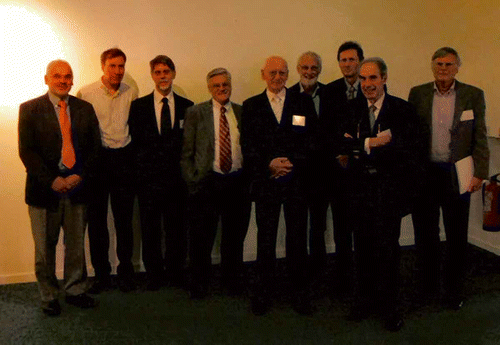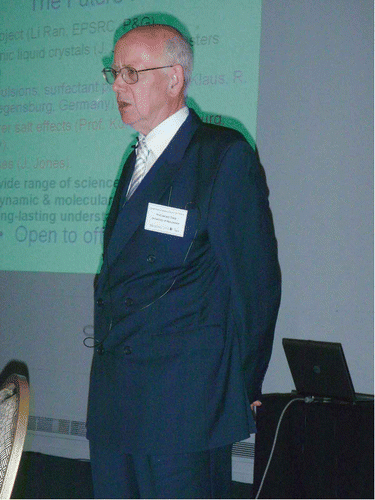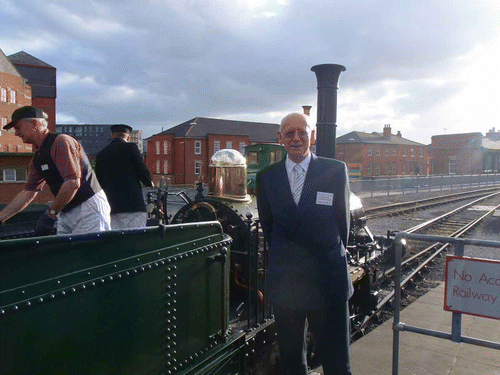Gordon Tiddy: lifetime in formulation science, 7 May 2009, Museum of Science and Industry, Manchester
Supported by The Royal Society of Chemistry, Formulation Science & Technology, SCI, Syngenta, Bosch and Chemspeed Technologies
For as far back as I can remember, Gordon Tiddy has been the figurehead of lyotropics in British liquid crystal circles. If you were organising a conference in this field, the only problem was deciding who you were going to invite to talk second. When Gordon stood up to speak, the atmosphere changed, you knew you were in for an entertaining ride. The trademark features never failed: the pretence at absolute conviction, especially with regard to that great evil concept of ‘water structure’ – which Gordon apparently regarded as a possible explanation for anything (and, therefore, for nothing whatsoever) and viewed as being somewhere between Devil Worship and the political philosophy of Margaret Thatcher; there was of course, the colourful language, as in his famous two-state (gnats' and pigs') model for liquid crystal viscosity; the shortcomings of senior management everywhere in general and at Unilever in particular; the Shakespearean delivery of the words ‘nearly right’ when describing the total misapprehensions of lesser mortals. None of this, of course, in any way hid his real authority, his width of knowledge and experience, the depth of understanding and a love for the subject itself.
The one occasion I recall, above all others, where these features came together perfectly, was Gordon's inaugural lecture, celebrating his chair at Salford. The great and the good from the liquid crystal fraternity across the country converged to hear him. It was his day and it rapidly became clear that he was going to enjoy every minute of it – and so of course, were we. It started off perfectly – every entertainer requires a straight man – and, of all people, the Vice Chancellor of Salford filled the role admirably, firstly by declaring, in some considerable detail, his long association with Gordon dating from their days together as students at East Anglia and then ruining the effect by getting his name wrong. From that moment onwards he sat conspicuously at the front looking puzzled whilst everyone else in the room roared with laughter as a succession of in-jokes were appreciated hugely by the audience: the toothpaste named for J. Willard, the pirated pictures of Gaugin and van Goch illustrating the use of domestic cleaning materials, the restricted intellect and vocabulary of senior management, which apparently does not include the words ‘small’ or even ‘medium’, the folly of lesser breeds without the (thermodynamic) law(s) who ignore the phase rule. It was an object lesson in how to play an audience. For an hour we were a large happy family sharing the same culture, background and humour.
The day at the science museum was different. Gordon was centre stage again – but it was a day of tribute from the penumbra around him, made up of colleagues from Europe and America, accumulated over 30 years, bridging industry and university life. On this occasion he was the eye of the storm and not the storm itself. It was an uncharacteristic situation, but he handled the elder statesman role graciously. For those of us who are familiar with the world of micelles, phase diagrams, optical textures, X-ray diffraction patterns and spectroscopy, it was rather a surprise to find that there was another world out there concerned with formulation that had an equally high opinion of Gordon.
The statistics indicate the scale of the event – nearly 100 people attended the full day of 11 lectures, coming from industry and universities across Britain and from both sides of the Atlantic. There was a fine display of 24 posters and the reception was in one of the most impressive locations in the north of England. John Jones and his organising committee did an admirable job.
The lectures spanned the whole spectrum of studies of lyotropic phases, covering the range of mesophase structures, foams, physical investigations using X-rays and various types of spectroscopy, formulation strategies, chromonic phases (and the production of nanoporous structures from them) and silicones. In a more restrained lecture than usual, Gordon gave a survey of his life in formulation science from the early ‘shelf-galloping’ approach of 40 years ago to the present day studies of microemulsions, specific ion effects, chromonics, foams and glycolipids.
As always, it is the asides that prove to be memorable. In conclusion to his talk on the aesthetic beauty of surfactant phase diagrams which included a discussion of the ‘holy system’ of water, fatty acid, salt and long chain alcohol, Håkan Wennerstrom repeated a quote that you don't hear too often, ‘I never travel anywhere without my phase diagrams’.
The last lecture, by Gilbert Schorsch from Rhone Poulenc, had an interesting opening. He was clearly intending on raising the tone of the proceedings by introducing some culture, and began an elegant talk about the synthesis and applications of silicone rubber with a slide of an old master painting of the Madonna with a pomegranate (a standard mediaeval symbol of fertility – presumably because of the large number of seeds it contains).
After the lectures, a treat was on offer for the Railway buffs – a trundle up half a mile of bumpy track and back again, behind a full size replica of the Comet (built by George Stephenson's son, Robert, in 1830) to remind us that this was one of the birthplaces of the industrial revolution. Afterwards, the dinner was in the main gallery of the museum – a wonderful place which could well serve as one of the ante-rooms of heaven. We ate alongside the largest steam locomotive I have ever seen – all 150 tons of a Beyer Garret GL loco returned to its birthplace after 30 years of service in South Africa. This was ambience it would be difficult to beat.
In contrast, at breakfast, post-industrial Manchester was bathed in early morning sunshine. Through the dining room windows of the hotel, we could see the results of falling pollution levels, with wildlife conspicuously returning to the inner city waterways. After an absence of a century, herons and cormorants were once again fishing in the canal. The wheel has turned full circle.
It was a day to savour – a reminder that Science is a human activity carried out by real people – some of them larger than life.
John Lydon
University of Leeds


